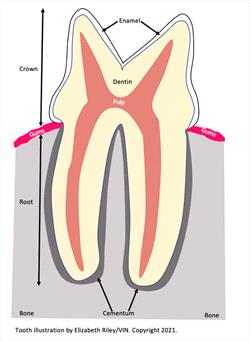Tooth resorption is a progressive disease that leads to loss or destruction of teeth. It is somewhat common in dogs, but we usually can’t see it with the naked eye. Instead, we often observe it through X-rays of the teeth. Tooth resorption can be painful and uncomfortable for your dog and can lead to infection and death of the tooth. Thus, it is important to diagnose and treat it.
Tooth Resorption Diagram

Image Courtesy of Elizabeth Riley
It is helpful to go over basic tooth anatomy before we describe tooth resorption in greater detail. The figure shows the parts of the tooth described. A dog’s tooth sits within a pocket of bone known as the alveolus or bone socket. The crown is the part of the tooth above the gum line, which we can see. The root is the part below the gum line, which we usually can’t see. The crown is covered in enamel, the hardest substance in the body, while the root is covered in a layer of bone-like material called cementum. Underneath these layers is dentin, which surrounds the pulp. The pulp is the innermost layer of the tooth and contains blood vessels and nerves. It is housed within a space in the center of the tooth; this space is called the root canal in the root and the pulp chamber in the crown.
What Causes Tooth Resorption?
Despite many theories, the cause isn’t known. However, we do have some understanding of what is happening at a microscopic level. During this disease process, cells called odontoclasts break down the hard tissue of a tooth. This destruction generally begins in the root and progresses from there.
What Are Signs My Dog Has Tooth Resorption?
Dogs may not show any signs of disease, especially if resorption only occurs in the root. However, your dog can experience pain and discomfort once resorption occurs above the gum line and exposes the dentin or pulp. At this point, you may notice the following signs:
- increased drooling;
- mouth bleeding;
- difficulty eating;
- fractured teeth.
How Will My Veterinarian Diagnose Tooth Resorption?
As always, your veterinarian will talk to you about your dog's problem history and perform a physical exam. This information will help the veterinarian rule out other causes and localize the issue to the mouth. Then, your veterinarian will need to take X-rays of your dog’s teeth to confirm they have tooth resorption and figure out which teeth are affected and how severe it is. This will require anesthesia since dogs (unlike humans) do not understand to hold still and not bite through the equipment while X-rays are taken.
How is Tooth Resorption Treated?
Treatment options include:
- Leaving the tooth and monitoring for worsening resorption or pain.
- Performing root canal therapy, which can be helpful to decrease or stop the tooth resorption progression. With this therapy, as in people, the root canal is cleared of pulp, cleaned, and filled with dental material.
- Removing part of the tooth and restoration of the remaining tooth.
- Removing the whole tooth. This is the preferred treatment once the tooth resorption is exposed to the oral cavity allowing bacteria to enter the tooth, causing inflammation.
To decide which treatment plan to pursue, your veterinarian will take into account a number of factors, including how much of the tooth is affected, how severe the resorption is, and where it is. For example, if the crown is affected, your veterinarian must remove the whole tooth to relieve pain. Once this procedure is over, painkillers may be prescribed to relieve discomfort. Assisted feeding might also be necessary until the mouth heals.
What Is the Prognosis for Tooth Resorption?
Once the affected teeth are removed, dogs generally do well. The prognosis is excellent. Root canal therapy carries a more guarded prognosis, as it may not alter the course of resorption of the tooth.